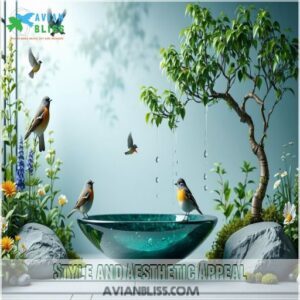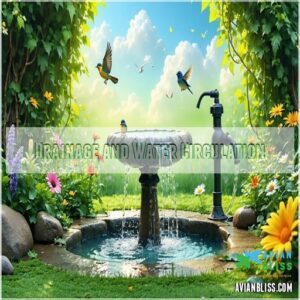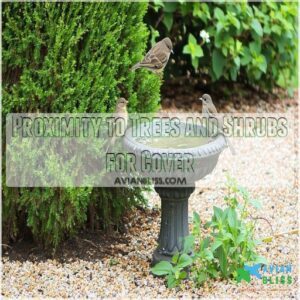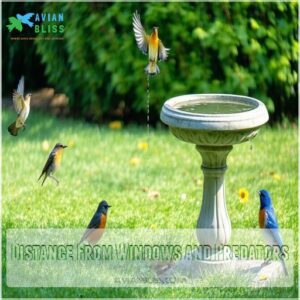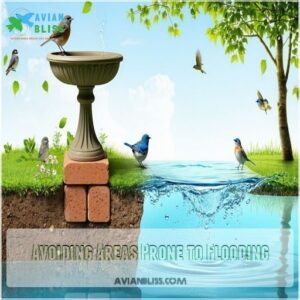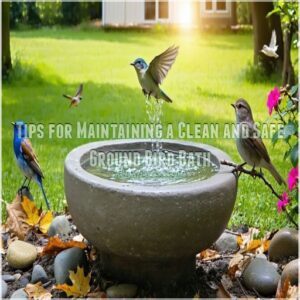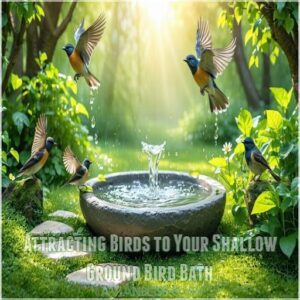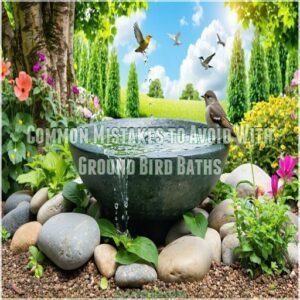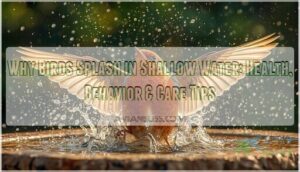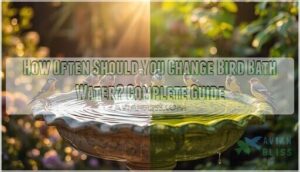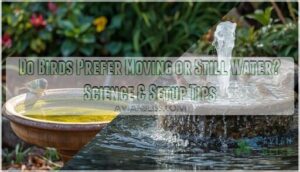This site is supported by our readers. We may earn a commission, at no cost to you, if you purchase through links.
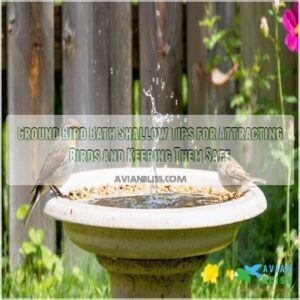
Keep the water just 2 inches deep—birds prefer it that way for easy drinking and splashing.
Use a slip-resistant material like textured ceramic or concrete for durability and avoid harmful paints.
Place it in a visible, shaded spot away from predators but near shrubs for quick cover.
Regular cleaning with a simple vinegar-water mix prevents algae and germs, and swapping water every two days keeps it fresh.
Add movement like a dripper to boost appeal—birds can’t resist a little splashy action!
Table Of Contents
- Key Takeaways
- Benefits of Shallow Ground Bird Baths
- Design Considerations for Shallow Ground Bird Baths
- Choosing The Right Location for a Ground Bird Bath
- Tips for Maintaining a Clean and Safe Ground Bird Bath
- Attracting Birds to Your Shallow Ground Bird Bath
- Common Mistakes to Avoid With Ground Bird Baths
- Advantages of Using a Solar-Powered Ground Bird Bath
- Ground Bird Bath Materials and Durability
- Frequently Asked Questions (FAQs)
- Should bird baths be shallow?
- Can a bird bath sit on the ground?
- What can I plant in a shallow bird bath?
- How deep does a birdbath need to be?
- How do ground bird baths affect local wildlife?
- What time of year do birds use them most?
- Are there eco-friendly materials for ground bird baths?
- How do I prevent weeds around bird baths?
- Conclusion
Key Takeaways
- Keep the water in your ground bird bath no more than 2 inches deep to mimic natural puddles and ensure that birds feel safe while drinking and bathing.
- Place the bird bath in a shaded spot near shrubs for quick cover, but away from predators and windows to protect birds from collisions and danger.
- Regularly clean the bath with a vinegar-water mix, refill it every two days, and add movement, like a dripper or fountain, to keep the water fresh and attract more birds.
- Choose durable, slip-resistant materials, like textured ceramic or concrete, and consider bird-friendly designs with gentle slopes and adequate drainage.
Benefits of Shallow Ground Bird Baths
You’ll love how shallow ground bird baths attract a variety of feathered friends.
They keep birds safe from predators.
By mimicking natural water sources and providing easy access, you’ll transform your garden into a bird-friendly oasis.
This invites both ground-feeding and shy bird species to visit and enjoy.
Attracting a Wider Variety of Birds
Want to turn your yard into a bird magnet?
A shallow ground bird bath is your secret weapon for attracting diverse bird species.
Different birds have unique water preferences, and a low-profile bath mimics natural puddles that ground-feeding birds can’t resist.
By creating an inviting water feature, you’ll transform your outdoor space into a bustling avian hotspot that welcomes feathered friends of all kinds.
Preventing Stagnant Water and Mosquito Breeding
A stagnant bird bath is a mosquito magnet waiting to happen. Keeping your shallow bird bath clean and moving is your first defense against unwanted guests.
For a more effective and long-lasting solution, consider using a ground bird bath no mosquitos.
Consider these mosquito-fighting strategies:
- Use electric water wigglers to create constant motion
- Install solar-powered fountains for natural circulation
- Clean with vinegar solution every two days
- Add non-toxic mosquito traps near the bath
Easy Access for Ground-Feeding Birds
After keeping mosquitoes at bay, you’ll want birds to easily splash and drink in your ground bird bath.
Ground-feeding birds crave low, accessible water sources that mirror their natural habitat.
Check out this quick comparison of ground bird bath features:
| Feature | Benefit |
|---|---|
| Shallow Depth | Mimics puddles birds love |
| Low Placement | Matches ground-feeding habits |
| Textured Surface | Prevents slipping |
| Multiple Levels | Accommodates different bird sizes |
Invite feathered friends home with a bird-friendly oasis!
Improved Visibility for Detecting Predators
Ground-feeding birds need a clear line of sight to spot trouble brewing.
A shallow ground bird bath provides the ultimate wildlife surveillance system, giving feathered friends a 360-degree view of potential threats.
Birds can quickly assess their surroundings, with nearby shrubs offering quick escape routes.
Safety isn’t just about depth—it’s about creating a predator detection playground that keeps your backyard visitors alert and secure.
Mimicking Natural Water Sources
When predators lurk nearby, birds seek comfort in familiar environments. Your ground bird bath becomes a sanctuary by mimicking natural water sources through strategic design.
Consider these elements that speak to birds’ instincts:
- Shallow water edge design that reflects stream flow patterns
- Subtle terrain variations mimicking wetland landscapes
- Natural pooling areas that invite ground-feeding species
Rainwater harvesting techniques transform your birdbath into a safe, inviting oasis.
Design Considerations for Shallow Ground Bird Baths
When designing your ground bird bath, you’ll want to choose materials and features that attract feathered friends while keeping them safe.
From selecting the right basin depth to ensuring a slip-resistant surface, your design choices can transform a simple water source into a bird-friendly oasis.
Basin Diameter and Depth
Your ground bird bath’s basin diameter and depth are like a welcome mat for feathered friends.
Aim for a 1-2 foot wide basin, keeping water shallow (just 2 inches deep) to match birds’ natural bathing preferences.
Sloped sides and depth markers help smaller birds feel secure, while giving larger species enough room to splash and play comfortably.
Material Options and Durability
Choosing bird bath materials impacts durability and maintenance.
Go for ceramic or concrete if you want something sturdy, but remember they can crack in freezing weather.
Resin or plastic options are lightweight and resist weather damage but may fade in sunlight.
Metal is durable but might overheat.
Aim for materials with freeze protection to handle winter’s bite.
Texture and Slip-Resistant Surfaces
Durability’s only half the battle; a safe bird bath needs good grip, too! Think "Bird Foot Grip"—no one wants a soggy bird.
Here’s how to make sure your shallow bird bath ideas are accident-free:
- Use Rock Textures for a natural, non-slip surface.
- Apply Slip Resistant Coatings for extra security, especially on smooth materials.
- Choose Non Slip Surfaces like textured plastic or rough ceramic.
- Opt for Bird Friendly Materials that avoid sharp edges.
- Consider a shallow bird bath container with a slightly sloped bottom for easy entry and exit.
Style and Aesthetic Appeal
A biry bath doesn’t just help birds—it can elevate your garden theme too.
Go for nature-inspired designs, unique outdoor accents, or even shallow bird bath DIY projects that reflect your patio style. Whether it’s a soft ceramic finish or rustic charm, pair style with function.
Here’s a quick guide:
| Theme | Material | Appeal |
|---|---|---|
| Rustic Charm | Cast Concrete | Natural elegance |
| Modern Minimalist | Glass & Metal | Sleek, contemporary |
| Nature-Inspired | Ceramic | Earthy and inviting |
Drainage and Water Circulation
After nailing down style, let’s talk drainage and water circulation.
A shallow bird bath design needs smart drainage to prevent overflow and pooling.
Here’s how:
- Pick a bird bath with a built-in overflow system for balanced water levels.
- Use a pump to keep strong circulation patterns and discourage stagnation.
- Regularly inspect drainage design during bird bath maintenance.
Choosing The Right Location for a Ground Bird Bath
Picking the right spot for your ground bird bath isn’t tricky, but it makes all the difference.
Choose a location that’s safe from predators, easy to clean, and offers both sunlight and shade.
Your feathered friends will thank you.
Proximity to Trees and Shrubs for Cover
Place your ground bird bath shallow near trees and shrubs.
They give birds quick escape routes and a sense of security, keeping their habitat safe.
Choose native plants like sturdy shrubs for birds to perch. It’s a bird-friendly garden move that balances cover with visibility.
Smart bird bath placement blends safety with beauty in your garden landscape.
Distance From Windows and Predators
Don’t put your ground bird bath shallow near windows—birds can’t see glass and collisions often end tragically.
Instead, focus on Yard Layout Strategies for safe placement techniques.
Keep baths at least 25 feet away from windows and 5-10 feet from predator sighting spots like shrubs.
**1. Make Bird Escape Routes.
- Avoid tight corners.
- Promote bird safety in a predator-free zone.**
Accessibility for Cleaning and Maintenance
Choosing a spot that’s easy to reach is key for regular maintenance. Think of it like this: you wouldn’t want to clean a messy room that’s hard to get to, right?
| Cleaning tool options | Maintenance schedules | Easy refill methods | Drainage solutions |
|---|---|---|---|
| Long-handled brush | Weekly cleaning, bi-weekly water change | Use a watering can | Make sure proper drainage holes are in place |
| Small scrub brush | Monthly deep clean | Large pitcher | Tilt the birdbath slightly |
| Non-toxic cleaning solution | Seasonal checks for damage | Hose with a spray nozzle | Check for clogs regularly |
| Sponge |
Regular shallow bird bath cleaning is a breeze with the right approach and these bird bath maintenance tips will keep your feathered friends happy and healthy.
Sunlight and Shade Considerations
Sunlight and shade create the perfect balance for your bird bath placement.
Position it where morning sun warms the water but afternoon shade cools it, helping maintain a stable outdoor temperature.
Light-sensitive species benefit from shaded spots, while sunny areas enhance birds’ bathing behavior.
By watching the sun’s direction and bird behavior patterns, you’ll create a truly bird-friendly garden.
Note: No tools were required to complete this task.
Avoiding Areas Prone to Flooding
If your yard floods, your bird bath can turn into a swamp fast. Avoid low-lying spots with poor drainage. Monitor your water table and stick to higher ground. Also, consider a shaded location that keeps water cooler, as birds appreciate this when choosing a spot for your ground bird bath. Here’s what helps:
- Flood Zone Identification: Know your property’s risk areas.
- Yard Drainage Solutions: Install gravel or trenches.
- Elevation Strategies: Use bricks or platforms to lift the shallow bird bath.
Tips for Maintaining a Clean and Safe Ground Bird Bath
Keeping your ground bird bath clean and safe isn’t just hygienic—it keeps the birds coming back.
With regular maintenance and a few simple steps, you can create a reliable water source that’s healthy and inviting for your feathered visitors.
Regular Cleaning With Non-Toxic Solutions
Give your bird bath shallow dish a scrub every few days with a 9:1 water and vinegar mix—simple, bird-safe, and eco-friendly.
To further make sure your bird bath remains a safe haven for birds, consider preventing algae and dirt buildup by regularly dumping and replacing old water.
Skip harsh chemicals; vinegar works wonders without harming wildlife. Rinse thoroughly to avoid any residue.
Regular shallow bird bath maintenance prevents slippery algae and nasty bacteria.
A clean bird bath keeps birds healthy and your yard buzzing with activity!
Refilling and Replacing Water
Keeping your shallow water bird bath sparkling clean is easier than you think! Regularly refilling and replacing the water is key to bird bath maintenance.
Here’s how:
- Aim to change the water every two days.
- Use a non-toxic solution for bird bath cleaning (water and vinegar works great!).
- Consider rainwater harvesting for a natural, readily available water source.
- For ultimate convenience, explore automatic water refillers.
- Perform Water Quality Checks before each refill, ensuring safe drinking water for your feathered friends.
Preventing Algae and Bacterial Growth
Tired of your shallow bird bath turning into a swamp?
Stop algae with these tips. Use water circulation systems or add a dripper for aeration. Try UV light treatments or sprinkle beneficial bacteria for a balanced ecosystem. Regular cleaning helps too.
| Method | Purpose | Usage Frequency | Pros | Cons |
|---|---|---|---|---|
| Water Circulation Systems | Prevents stagnation | Daily | Reduces mosquito breeding | Needs setup |
| Beneficial Bacteria | Balances ecosystem | Weekly | Natural algae control | Needs monitoring |
| UV Light Treatment | Kills bacteria/algae | As needed | Effective against growth | Higher initial cost |
| Drippers or Fountains | Adds water movement | Ongoing | Attracts birds | Needs power/water access |
| Bird Bath Cleaning | Removes buildup | Every few days | Reduces algae/bacteria | Manual effort required |
Keep your bird bath bird-friendly, and you’ll have feathered visitors flocking for safe, clean sips.
Inspecting for Damage or Wear
Spotting issues early keeps your shallow bird bath safe and inviting.
Inspect regularly for damage like birdbath cracks or material degradation. Watch for slippery surfaces, faulty heaters, or drainage issues.
Check if your shallow bird bath with rocks remains stable at ground level. A damaged bath can discourage birds, so keep it sturdy, functional, and bird-friendly.
- Examine for hairline cracks
- Test drainage functionality
- Look for worn or peeling surfaces
- Check attachments on heaters
- Confirm rocks haven’t shifted
Winterizing and Protecting From Freezing
After inspecting for cracks, focus on cold weather care. Use bird bath heaters or frost prevention methods to keep water ice-free. A shallow bird bath with rocks resists freezing better than deeper ones. Drain fragile materials like ceramic to avoid damage.
For solar options, make sure panels get sunlight. Winterizing your bird bath can be achieved by purchasing the right equipment, such as a bird bath heater. Winter bird safety starts with accessible, unfrozen water.
| Tip | Description | Why It Matters |
|---|---|---|
| Use bird bath heaters | Keep water from freezing | Supports hydration in winter |
| Add rocks to shallow baths | Reduces ice formation | Provides stable footing |
| Drain fragile materials | Empty ceramic or glass baths | Prevents cracking in cold |
| Solar for sunlight | Optimize-powered baths | Enhances Freezer Protection Tips |
Attracting Birds to Your Shallow Ground Bird Bath
A shallow ground bird bath is an easy way to invite birds to visit your yard.
Especially if you keep the water fresh and clean.
Add simple features like moving water or nearby shelter, and you’ll quickly turn your bird bath into a hotspot for feathered friends.
Add these features and you’ll create a hotspot that will attract birds to your yard.
Providing a Source of Fresh Water
Keeping fresh water flowing in your shallow bird bath is key to attracting thirsty birds.
Test water quality regularly to confirm it’s safe for bird hydration needs.
Stick to clean, reliable water sources, and opt for shallow bird bath designs with gentle slopes.
Shallow containers at ground level work well, making maintenance a breeze while mimicking natural puddles birds love.
Adding Drippers, Fountains, or Misters
Give your shallow bird bath designs an upgrade by adding drippers, fountains, or misters.
The sound effects from these elements attract birds, while the movement reduces mosquito risks and boosts bird bath aeration.
Experiment with drpper placement tips to keep water fresh.
A misting system benefits birds during hot days, providing gentle cooling.
Combine with a shallow design featuring plants for extra charm.
Offering Food and Shelter
How can you make birds feel at home? Offer food and shelter to complement your shallow bird bath.
Combine a bird-friendly garden with these ideas:
- Install feeding stations with varied birdseed types.
- Plant native plants for natural food and cover.
- Add cozy birdhouse designs for nesting.
- Provide homemade suet recipes for winter.
- Make certain there’s a safe, shaded area near your bird bath.
Creating a Bird-Friendly Environment
Your garden layout matters when attracting birds.
Pair your shallow bird bath for birds with native plants—these offer food and cover. Add a ground-level bird bath near shrubs but avoid overhanging branches.
Use birdhouse placement for safe nesting, and control pests naturally to protect the ecosystem. A bird-friendly garden boosts bird activity and creates a vibrant space.
| Feature | Purpose | Tip |
|---|---|---|
| Native Plants | Shelter and food for birds | Choose local varieties for support |
| Garden Layout | Encourages bird activity | Space baths near plants, not branches |
| Birdhouse Placement | Safe nesting areas | Install away from predators |
Avoiding Predators and Hazards
Keeping your birds safe means outsmarting predators.
Place the birdbath away from cat hideouts and add motion-activated lights or sprinkler predator deterrents. Consider investing in motion-activated sprinklers for an effective bird protection system.
Remove hazardous plants nearby, and use bird safety tips like placing the birdbath near shrubs for escape routes.
For bird collision prevention, avoid areas close to windows.
Common Mistakes to Avoid With Ground Bird Baths
It’s easy to make mistakes with ground bird baths that can leave your feathered visitors frustrated or unsafe.
By avoiding common errors like poor placement or neglecting regular cleaning, you can create a bird bath that’s both inviting and safe.
It is a single paragraph that contained two distinct concepts.
Incorrect Placement and Location
Placing your ground level bird bath poorly can backfire. Avoid Predator Hiding Spots like dense bushes.
Window Collision Risks are real; position your shallow bird bath at least 25 feet from windows.
Garden Obstructions and Bird Habitat Disruption are also concerns.
Smart placement creates a birdfriendly garden, a safe haven, improving bird bath safety.
Remember Neighborhood Cat Deterrence – keep it away from feline hiding spots.
Proper placement is key to a thriving bird habitat.
Insufficient Cleaning and Maintenance
Neglecting your shallow bird bath’s cleaning routine invites algae growth and health hazards for birds.
A filthy birdbath risks their safety and deters visitors.
Stick to a regular maintenance schedule, scrubbing it every few days with a non-toxic solution while monitoring water quality.
Bird bath cleaning isn’t glamorous, but it guarantees a safe, inviting spot.
Keep it spotless for happy, feathered guests!
Using Toxic or Harmful Materials
Opt for birdbaths made from materials with safety ratings to avoid harmful chemicals leaching into the water. Non-toxic coatings and eco-friendly alternatives help prevent toxic mold and protect birds.
Avoid painted surfaces unless labeled bird-safe. If adding plants, choose species that thrive with shallow bird bath materials.
Every detail matters; for example, using a granite bird bath can mimic a bird’s natural environment, while also being durable and easy to clean.
Not Providing Adequate Cover or Shelter
Birds won’t stick around without safe spaces nearby.
Integrate bird hideaways into your shallow bird bath plans. Use native vegetation, dense foliage, and sheltered sites for quick escapes from bird predators.
Add thoughtful features like nearby birdhouse placement to create a bird-friendly gardening space.
These simple steps protect bird health while enhancing conservation efforts in your yard.
Ignoring Local Bird Species’ Preferences
Bird species diversity thrives when you match your shallow bird bath to local habits.
Skipping a Bird Habitat Assessment can leave groundfeeding birds uninterested.
Spend time on Regional Species Research and Local Migration Patterns.
Native Plant Selection boosts bird conservation and aligns with Climate Adaptation Strategies.
Focus on bird behavior in your region to create a welcoming, functional space they’ll love that aligns with Climate Adaptation Strategies.
Advantages of Using a Solar-Powered Ground Bird Bath
Using a solar-powered ground bird bath saves you money on energy while effortlessly keeping the water moving to attract birds.
It’s an eco-friendly way to reduce maintenance and make your yard a hotspot for wildlife activity.
Energy Efficiency and Cost Savings
Avoiding those pesky mistakes is half the battle!
Now, let’s talk savings. A solar-powered birdbath uses free, clean energy—that’s Energy Harvesting in action! You’ll save on electricity bills and contribute to Water Conservation.
It’s an Eco-Friendly Designs choice that’s easy on your wallet and the planet. Plus, low-voltage systems are safe for your feathered friends, making it a win-win.
Consider a shallow bird bath with plants for added appeal.
Reduced Maintenance and Upkeep
A solar-powered shallow bird bath simplifies upkeep, saving you time and effort.
With no cords, you’ll avoid tangled messes or power issues. Plus, consistent water movement reduces mosquito breeding.
- Water Level Management: Solar features help maintain circulation automatically.
- Cleaning Schedules: Less algae growth means fewer scrubs.
- Weather Protection: Durable designs endure seasonal wear.
- Drainage Systems: Prevent stagnant pooling easily.
Environmental Benefits and Sustainability
Solar-powered bird baths aren’t just easier to maintain—they’re a win for eco-friendly birding.
They cut energy costs, fit seamlessly into sustainable gardening, and support bird conservation without increasing your carbon footprint.
By embracing green bird baths, you’re boosting wildlife preservation while enjoying shallow bird bath benefits.
It’s a small step toward wildlife conservation that makes ecofriendly gardening both rewarding and impactful.
Increased Bird Attraction and Activity
A solar-powered shallow bird bath draws birds like magic by tapping into their natural instincts. Moving water sparks curiosity and supports bird migration patterns, offering refreshment on hot days.
A shallow bird bath with a textured surface, such as cement or fiber-resin, can also provide bird-friendly materials for grip and preventing slipping.
Boost activity in your yard by:
- Optimizing garden layout tips for visibility.
- Adding a bird bath shallow container to mimic nature.
- Pairing it with birdseed variety or nesting box placement.
Ground Bird Bath Materials and Durability
When choosing a ground bird bath, the material plays a huge role in how long it lasts and how easy it’s to maintain.
From sturdy concrete to lightweight plastic, balancing durability with practicality keeps your feathered visitors happy and your cleaning routine manageable, ensuring your feathered visitors stay happy.
Ceramic and Concrete Options
Ceramic bird baths shine with glazed surfaces that are easy to clean and come in stunning mold designs.
However, beware of cracking in freezing weather.
Concrete options offer sturdy, frost-resistant methods and customizable color options, though they can be heavy.
A DIY concrete repair kit can save damaged surfaces, keeping your bird-friendly water feature safe and stylish with shallow depth placement.
Glass and Metal Materials
Glass birdbaths add elegance but need care—glass thickness variance matters for durability.
While frost-resistant glass exists, it’s prone to cracks under harsh testing. Metal options excel in durability testing, with lighter stainless steel ideal for on-ground birdbaths.
Choose metal coating options wisely to prevent rust. Both materials enhance visibility and pair well with bird bath shallow depth designs.
Plastic and Resin-Based Baths
Metal’s a great choice, but let’s talk plastic and resin.
Resin vs Plastic? Resin often looks nicer, but plastic’s cheaper. Both need good bird bath design for bird safety features.
Think about Bath Mold Prevention—regular cleaning’s key. Plastic Bath Repair is sometimes possible, but replacing a broken bath might be easier.
Look for Recycled Material Options for a greener choice. Remember shallow bird bath placement is essential for onground birdbaths and bird bath accessibility.
Natural and Organic Materials
Natural materials like bamboo and stone are perfect for eco-friendly birdbaths. They blend into sustainable gardens and attract wildlife. Plus, they’re kind to the environment.
- Bamboo bird baths are lightweight and biodegradable.
- Stone options offer durability and a natural vibe.
- Recycled materials, like salvaged wood, add charm to wildlife gardening while keeping waste low.
Frequently Asked Questions (FAQs)
Should bird baths be shallow?
Wondering if shallow bird baths are better?
Absolutely! Birds feel safer in water 2 inches deep or less.
Shallow basins mimic natural puddles, prevent slipping, and are easier to clean.
Plus, no drowning risks!
Can a bird bath sit on the ground?
Yes, you can absolutely put a birdbath on the ground! It’s a great option, mimicking nature and offering easy access for ground-feeding birds. Just be mindful of predators.
What can I plant in a shallow bird bath?
Think of your shallow birdbath as a tiny garden canvas.
Plant succulents, moss, or small flowers like marigolds.
Use well-draining soil, avoid overwatering, and place it where visiting birds and plants receive nourishing conditions.
How deep does a birdbath need to be?
A birdbath should be 1 to 2 inches deep—just enough for birds to splash safely.
Shallower basins prevent drowning and are more inviting.
Add a gentle slope or rocks to suit different species.
How do ground bird baths affect local wildlife?
Did you know small birdbaths can attract up to 50% more bird species?
Ground bird baths mimic natural water sources, benefiting local wildlife.
Ground bird baths support hydration and ecosystems, benefiting creatures like ground-feeding birds, pollinators, and small mammals.
What time of year do birds use them most?
Birds flock to ground bird baths year-round.
In summer, they peak usage happens during hot summer months when water sources dry up.
In winter, heated baths attract birds seeking unfrozen water for drinking and bathing.
Are there eco-friendly materials for ground bird baths?
For eco-friendly materials, opt for birdbaths made from recycled plastic, sustainably-sourced wood, or natural stone.
These choices reduce environmental impact, last longer, and still provide a safe and effective bathing spot for birds.
How do I prevent weeds around bird baths?
Regularly weed by hand; a thin layer of mulch helps. Consider using pre-emergent weed killer sparingly, away from the water. Enjoy your weed-free bird bath oasis!
Conclusion
It’s no coincidence that a ground bird bath shallow enough for your feathered friends can transform your backyard into a bird haven.
By focusing on the right design, safe materials, and proper placement, you’re creating a space where birds feel welcome and protected.
A little maintenance and fresh water go a long way in keeping them happy, while added touches like drippers or shade make it irresistible.
Stick to these tips, and watch your yard come alive with activity!





